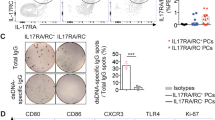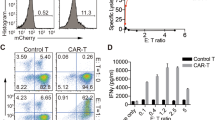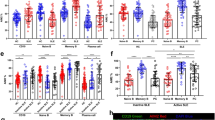Abstract
A hallmark of systemic lupus erythematosus (SLE) is the consistent production of various auto-antibodies by auto-reactive B cells. Interferon-α (IFN-α) signaling is highly activated in SLE B cells and plays a vital role in the antibody response by B cells. Previous studies have shown that CD180-negative B cells, which are dramatically increased in SLE patients, are responsible for the production of auto-antibodies. However, the association between CD180 and IFN-α signaling remains unknown. In the present study, we explored the effect of CD180 on regulating the activation of IFN-α signaling in B cells. We found that the number of CD180-negative B cells was increased in MRL/Mp-Fas(lpr/lpr) lupus-prone mice compared with wild-type mice. Phenotypic analysis showed that CD180-negative B cells comprised CD138+ plasmablast/plasma cells and GL-7+ germinal center (GC) B cells. Notably, ligation of CD180 significantly inhibited the IFN-α-induced phosphorylation of signal transducer and activator of transcription 2 (STAT-2) and expression of IFN-stimulated genes (ISGs) in a Lyn-PI3K-BTK-dependent manner in vitro. Moreover, ligation of CD180 could also inhibit IFN-α-induced ISG expression in B cells in vivo. Furthermore, the Toll-like receptor 7 and Toll-like receptor 9 signaling pathways could significantly downregulate CD180 expression and modulate the inhibitory effect of CD180 signaling on the activation of IFN-α signaling. Collectively, our results highlight the close association between the increased proportion of CD180-negative B cells and the activation of IFN-α signaling in SLE. Our data provide molecular insight into the mechanism of IFN-α signaling activation in SLE B cells and a potential therapeutic approach for SLE treatment.
This is a preview of subscription content, access via your institution
Access options
Subscribe to this journal
Receive 12 digital issues and online access to articles
$119.00 per year
only $9.92 per issue
Buy this article
- Purchase on Springer Link
- Instant access to full article PDF
Prices may be subject to local taxes which are calculated during checkout







Similar content being viewed by others
References
Kotzin BL . Systemic lupus erythematosus. Cell 1996; 85: 303–306.
Dorner T, Giesecke C, Lipsky PE . Mechanisms of B cell autoimmunity in SLE. Arthritis Res Ther 2011; 13: 243.
Avalos AM, Busconi L, Marshak-Rothstein A . Regulation of autoreactive B cell responses to endogenous TLR ligands. Autoimmunity 2010; 43: 76–83.
Kirou KA, Lee C, George S, Louca K, Peterson MG, Crow MK . Activation of the interferon-alpha pathway identifies a subgroup of systemic lupus erythematosus patients with distinct serologic features and active disease. Arthritis Rheum 2005; 52: 1491–1503.
Kim T, Kanayama Y, Negoro N, Okamura M, Takeda T, Inoue T . Serum levels of interferons in patients with systemic lupus erythematosus. Clin Exp Immunol 1987; 70: 562–569.
Ytterberg SR, Schnitzer TJ . Serum interferon levels in patients with systemic lupus erythematosus. Arthritis Rheum 1982; 25: 401–406.
Baechler EC, Batliwalla FM, Karypis G, Gaffney PM, Ortmann WA, Espe KJ et al. Interferon-inducible gene expression signature in peripheral blood cells of patients with severe lupus. Proc Natl Acad Sci USA 2003; 100: 2610–2615.
Fan H, Liu F, Dong G, Ren D, Xu Y, Dou J et al. Activation-induced necroptosis contributes to B-cell lymphopenia in active systemic lupus erythematosus. Cell Death Dis 2014; 5: e1416.
Becker AM, Dao KH, Han BK, Kornu R, Lakhanpal S, Mobley AB et al. SLE peripheral blood B cell, T cell and myeloid cell transcriptomes display unique profiles and each subset contributes to the interferon signature. PLoS One 2013; 8: e67003.10.
Braun D, Caramalho I, Demengeot J . IFN-alpha/beta enhances BCR-dependent B cell responses. Int Immunol 2002; 14: 411–419.
Bekeredjian-Ding IB, Wagner M, Hornung V, Hornung V, Giese T, Schnurret M et al. Plasmacytoid dendritic cells control TLR7 sensitivity of naive B cells via type-I IFN. J Immunol 2005; 174: 4043–4050.
Thien M, Phan TG, Gardam S, Amesbury M, Basten A, Mackay F et al. Excess BAFF rescues self-reactive B cells from peripheral deletion and allows them to enter forbidden follicular and marginal zone niches. Immunity 2004; 20: 785–798.
Mathian A, Gallegos M, Pascual V, Banchereau J, Koutouzov S . Interferon-alpha induces unabated production of short-lived plasma cells in pre-autoimmune lupus-prone (NZB×NZW) F1 mice but not in BALB/c mice. Eur J Immunol 2011; 41: 863–872.
Uccellini MB, Busconi L, Green NM, Busto P, Christensen SR, Shlomchik MJ et al. Autoreactive B cells discriminate CpG-Rich and CpG-Poor DNA and this response is modulated by IFN-alpha. J Immunol 2008; 181: 5875–5884.
Lau CM, Broughton C, Tabor AS, Akira S, Flavell RA, Mamula MJ et al. RNA-associated autoantigens activate B cells by combined B cell antigen receptor/Toll-like receptor 7 engagement. J Exp Med 2005; 202: 1171–1177.
Green NM, Laws A, Kiefer K, Busconi L, Kim YM, Brinkmann MM et al. Murine B cell response to TLR7 ligands depends on an IFN-beta feedback loop. J Immunol 2009; 183: 1569–1576.
Oganesyan G, Saha SK, Pietras EM, Guo B, Miyahira AK, Zarnegar B et al. IRF3-dependent type I interferon response in B cells regulates CpG-mediated antibody production. J Biol Chem 2008; 283: 802–808.
Miyake K, Shimazu R, Kondo J, Niki T, Akashi S, Ogata H et al. Mouse MD-1, a molecule that is physically associated with RP105 and positively regulates its expression. J Immunol 1998; 161: 1348–1353.
Miura Y, Shimazu R, Miyake K, Akashi S, Ogata H, Yamashita Y et al. RP105 is associated with MD-1 and transmits an activation signal in human B cells. Blood 1998; 92: 2815–2822.
Divanovic S, Trompette A, Atabani SF, Madan R, Golenbock DT, Visintin A et al. Negative regulation of toll-like receptor 4 signaling by the toll-like receptor homolog RP105. Nat Immunol 2005; 6: 571–578.
Miyake K, Yamashita Y, Ogata M, Sudo T, Kimoto M . RP105, a novel B cell surface molecule implicated in B cell activation, is a member of the leucine-rich repeat protein family. J Immunol 1995; 154: 3333–3340.
Miyake K, Yamashita Y, Hitoshi Y, Takatsu K, Kimoto M . Murine B cell proliferation and protection from apoptosis with an antibody against a 105-kD molecule unresponsiveness of X-linked immunodeficient B cells. J Exp Med 1994; 180: 1217–1224.
Chan VW, Mecklenbräuker I, Su I, Texido G, Leitges M, Carsetti R et al. The molecular mechanism of B cell activation by toll-like receptor protein RP-105. J Exp Med 1998; 188: 93–101.
Yazawa N, Fujimoto M, Sato S, Miyake K, Asano N, Nagai Y et al. CD19 regulates innate immunity by the toll-like receptor RP105 signaling in B lymphocytes. Blood 2003; 102: 1374–1380.
Koarada S, Tada Y, Ushiyama O, Morito F, Suzuki N, Ohta A . B cells lacking RP105, a novel B cell antigen, in systemic lupus erythematosus. Arthritis Rheum 1999; 42: 2593–2600.
Kikuchi Y, Koarada S, Tada Y, Ushiyama O, Morito F, Suzuki N et al. RP105-lacking B cells from lupus patients are responsible for the production of immunoglobulins and autoantibodies. Arthritis Rheum 2002; 46: 3259–3265.
Fujita K, Akasaka Y, Kuwabara T, Wang B, Tanaka K, Kamata I et al. Pathogenesis of lupus-like nephritis through autoimmune antibody produced by CD180-negative B lymphocytes in NZB/W F1 mouse. Immunol Lett 2012; 144: 1–6.
Koarada S, Tada Y, Suematsu R, Soejima S, Inoue H, Ohta A et al. Phenotyping of RP105-negative B cell subsets in patients with systemic lupus erythematosus. Clin Dev Immunol 2012; 2012: 198–206.
Luzina IG, Atamas SP, Storrer CE, da Silva LC, Kelsoe G, Papadimitriou JC et al. Spontaneous formation of germinal centers in autoimmune mice. J Leukoc Biol 2001; 70: 578–584.
Chaplin JW, Kasahara S, Clark EA, Ledbetter JA . Anti-CD180 (RP105) activates B cells to rapidly produce polyclonal Ig via a T cell and MyD88-independent pathway. J Immunol 2011; 187: 4199–4209.
Yamazaki K, Yamazaki T, Taki S, Miyake K, Hayashi T, Ochs HD et al. Potentiation of TLR9 responses for human naive B-cell growth through RP105 signaling. Clin Immunol 2010; 135: 125–136.
Platanias LC . Mechanisms of type-I- and type-II-interferon-mediated signalling. Nat Rev Immunol 2005; 5: 375–386.
Wen Z, Zhong Z, Darnell JE Jr . Maximal activation of transcription by Statl and Stat3 requires both tyrosine and serine phosphorylation. Cell 1995; 82: 241–250.
Pilz A, Ramsauer K, Heidari H, Leitges M, Kovarik P, Decker T . Phosphorylation of the Stat1 transactivating domain is required for the response to type I interferons. EMBO Rep 2003; 4: 368–373.
Nguyen H, Ramana CV, Bayes J, Stark GR . Roles of phosphatidylinositol 3-kinase in interferon-γ-dependent phosphorylation of STAT1 on serine 727 and activation of gene expression. J Biol Chem 2001; 276: 33361–33368.
Du Z, Shen Y, Yang W, Mecklenbrauker I, Neel BG, Ivashkiv LB et al. Inhibition of IFN-alpha signaling by a PKC- and protein tyrosine phosphatase SHP-2-dependent pathway. Proc Natl Acad Sci USA 2005; 102: 10267–10272.
HuangFu WC, Qian J, Liu C, Liu J, Lokshin AE, Baker DP et al. Inflammatory signaling compromises cell responses to interferon alpha. Oncogene 2012; 31, 161–172.
Sasaki S, Nagai Y, Yanagibashi T, Watanabe Y, Ikutani M, Kariyone A et al. Serum soluble MD-1 levels increase with disease progression in autoimmune prone MRL/lpr mice. Mol Immunol 2012; 49: 611–620.
Odendahl M, Jacobi A, Hansen A, Feist E, Hiepe F, Burmester GR et al. Disturbed peripheral B lymphocyte homeostasis in systemic lupus erythematosus. J Immunol 2000; 165: 5970–5979.
Odendahl M, Keitzer R, Wahn U, Hiepe F, Radbruch A, Dörner T et al. Perturbations of peripheral B lymphocyte homoeostasis in children with systemic lupus erythematosus. Ann Rheum Dis 2003; 62: 851–858.
Culton DA, O’Conner BP, Conway KL, Diz R, Rutan J, Vilen BJ et al. Early preplasma cells define a tolerance checkpoint for autoreactive B cells. J Immunol 2006; 176: 790–802.
Hoyer BF, Moser K, Hauser AE, Peddinghaus A, Voigt C, Eilat D et al. Short-lived plasmablasts and long-lived plasma cells contribute to chronic humoral autoimmunity in NZB/W mice. J Exp Med 2004; 199: 1577–1584.
Vinuesa CG, Sanz I, Cook MC . Dysregulation of germinal centres in autoimmune disease. Nat Rev Immunol 2009; 9: 845–857.
Cheng Q, Mumtaz IM, Khodadadi L, Radbruch A, Hoyer BF, Hiepe F . Autoantibodies from long-lived ‘memory’ plasma cells of NZB/W mice drive immune complex nephritis. Ann Rheum Dis 2013; 72: 2011–2017.
Weinstein JS, Delano MJ, Xu Y, Kelly-Scumpia KM, Nacionales DC, Li Y et al. Maintenance of anti-Sm/RNP autoantibody production by plasma cells residing in ectopic lymphoid tissue and bone marrow memory B cells. J Immunol 2013; 190: 3916–3927.
Wilson LE, Widman D, Dikman SH, Gorevic PD . Autoimmune disease complicating antiviral therapy for hepatitis C virus infection. Semin Arthritis Rheum 2002; 32: 163–173.
Ronnblom LE, Alm GV, Oberg KE . Autoimmunity after alpha-interferon therapy for malignant carcinoid tumors. Ann Intern Med 1991; 115: 178–183.
Adam C, Thoua Y, Ronco P, Verroust P, Tovey M, Morel-Maroger L . The effect of exogenous interferon: acceleration of autoimmune and renal diseases in (NZB/W) F1 mice. Clin Exp Immunol 1980; 40: 373–382.
Heremans H, Billiau A, Colombatti A, Hilgers J, de Somer P . Interferon treatment of NZB mice: accelerated progression of autoimmune disease. Infect Immun 1978; 21: 925–930.
Crow MK . Interferon-alpha: a therapeutic target in systemic lupus erythematosus. Rheum Dis Clin North Am 2010; 36: 173–186.
Yao Y, Richman L, Higgs BW, Morehouse CA, de los Reyes M, Brohawn P et al. Neutralization of interferon-alpha/beta-inducible genes and downstream effect in a phase I trial of an anti-interferon-alpha monoclonal antibody in systemic lupus erythematosus. Arthritis Rheum 2009; 60: 1785–1796.
Hwang SH, Lee H, Yamamoto M, Jones LA, Dayalan J, Hopkins RB et al. B cell TLR7 expression drives anti-RNA autoantibody production and exacerbates disease in systemic lupus erythematosus-prone mice. J Immunol 2012; 189: 5786–5796.
Chaplin JW, Chappell CP, Clark EA . Targeting antigens to CD180 rapidly induces antigen-specific IgG, affinity maturation, and immunological memory. J Exp Med 2013; 210: 2135–2146.
Xu W, Nair JS, Malhotra A, Zhang JJ . B cell antigen receptor signaling enhances IFN-gamma-induced Stat1 target gene expression through calcium mobilization and activation of multiple serine kinase pathways. J Interferon Cytokine Res 2005; 25: 113–124.
Chan VWF, Meng F, Soriano P, DeFranco AL, Lowell CA . Characterization of the B lymphocyte populations in Lyn-deficient mice and the role of Lyn in signal initiation and down-regulation. Immunity 1997; 7: 69–81.
Kikuchi Y, Koarada S, Nakamura S, Yonemitsu N, Tada Y, Haruta Y et al. Increase of RP105-lacking activated B cells in the peripheral blood and salivary glands in patients with Sjögren’s syndrome. Clin Exp Rheumatol 2008; 26: 5–12.
Miguet L, Lennon S, Baseggio L, Traverse-Glehen A, Berger F, Perrusson N et al. Cell-surface expression of the TLR homolog CD180 in circulating cells from splenic and nodal marginal zone lymphomas. Leukemia 2013; 27: 1748–1750.
Ren D, Liu F, Dong G, You M, Ji J, Huang Y et al. Activation of TLR7 increases CCND3 expression via the downregulation of miR-15b in B cells of systemic lupus erythematosus. Cell Mol Immunol 2015; 10: in press.
Dong G, You M, Fan H, Ding L, Sun L, Hou Y . STS-1 promotes IFN-α-induced autophagy by activating the JAK1-STAT1 signaling pathway in B cells. Eur J Immunol 2015; 10: in press.
Kobayashi T, Takahashi K, Nagai Y, Shibata T, Otani M, Izui S et al. Tonic B cell activation by radioprotective105/MD-1 promotes disease progression in MRL/lpr mice. Int Immunol 2008; 20: 881–891.
Acknowledgements
This work was supported by a grant from National Natural Science Foundation of China (Project number: 31370899).
Author information
Authors and Affiliations
Ethics declarations
Competing interests
The authors declare that they have no conflict of interest.
Additional information
Supplementary information of this article can be found on Cellular & Molecular Immunology website: http://www.nature.com/cmi.
Supplementary information
Rights and permissions
About this article
Cite this article
You, M., Dong, G., Li, F. et al. Ligation of CD180 inhibits IFN-α signaling in a Lyn-PI3K-BTK-dependent manner in B cells. Cell Mol Immunol 14, 192–202 (2017). https://doi.org/10.1038/cmi.2015.61
Received:
Revised:
Accepted:
Published:
Issue Date:
DOI: https://doi.org/10.1038/cmi.2015.61
Keywords
This article is cited by
-
B-1 derived anti-Thy-1 B cells in old aged mice develop lymphoma/leukemia with high expression of CD11b and Hamp2 that different from TCL1 transgenic mice
Immunity & Ageing (2024)
-
RP105 Attenuates Ischemia/Reperfusion-Induced Oxidative Stress in the Myocardium via Activation of the Lyn/Syk/STAT3 Signaling Pathway
Inflammation (2024)
-
The role of CD180 in hematological malignancies and inflammatory disorders
Molecular Medicine (2023)
-
Single-cell RNA-Seq reveals transcriptional heterogeneity and immune subtypes associated with disease activity in human myasthenia gravis
Cell Discovery (2021)
-
Src Family Protein Kinase Controls the Fate of B Cells in Autoimmune Diseases
Inflammation (2021)



